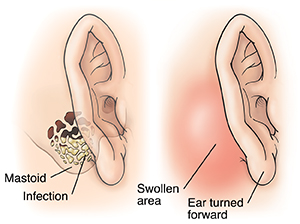When Your Child Has Mastoiditis
Your child has mastoiditis. This is an infection of the mastoid—he hard, bony area located right behind the ear. It's most often the result of an infection that started in the middle ear and spread to the bone.
 |
| Infection of the mastoid can cause the skin above it to swell. This swelling can cause the ear to turn forward. |
Who is at risk for mastoiditis?
Mastoiditis is more common in children than adults. Having any of the following may make getting it more likely:
What are the symptoms of mastoiditis?
-
Fever
-
Ear pain
-
Swelling over the mastoid bone (bone behind the ear), causing the ear to turn forward
-
Redness, tenderness, or swelling behind the ear
-
Drainage from the ear canal or dizziness
-
Weakened facial muscles (uncommon)
How is mastoiditis diagnosed?
Your child’s healthcare provider will ask about your child’s medical history. They will also do a physical exam. This helps find the best treatment. An imaging test such as CT scan or MRI may be done to help the healthcare provider make a diagnosis and view the mastoid area.
How is mastoiditis treated?
If mastoiditis is suspected, your child may be admitted into the hospital for evaluation and treatment. The hospital stay can last for 5 to 7 days or more. In the hospital, your child will be given IV (intravenous) antibiotics for the infection. Your child will see an otolaryngologist. This is a doctor who specializes in treating problems of the ears, nose, and throat (ENT). The ENT doctor may need to make a tiny incision in the eardrum to allow trapped fluid to drain out. This is called a myringotomy. It relieves pressure and the fluid can be tested. The test results help the ENT doctor determine which antibiotic to give your child. If these treatments don’t work, your child may need surgery to remove parts of the infected mastoid. This is called a mastoidectomy.
Long-term concerns
Once treated, the mastoid often causes no long-term problems. But if left untreated, mastoiditis can lead to a serious infection in and around the brain. To protect your child’s health, follow up with their regular healthcare provider.
Online Medical Reviewer:
Amy Finke RN BSN
Online Medical Reviewer:
Ashutosh Kacker MD
Online Medical Reviewer:
Tara Novick BSN MSN
Date Last Reviewed:
12/1/2022
© 2000-2024 The StayWell Company, LLC. All rights reserved. This information is not intended as a substitute for professional medical care. Always follow your healthcare professional's instructions.